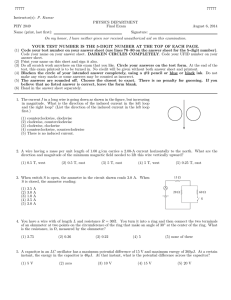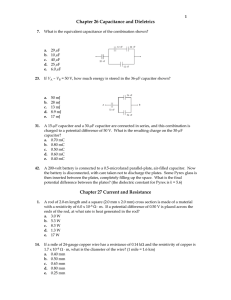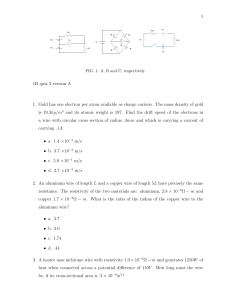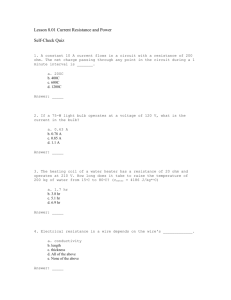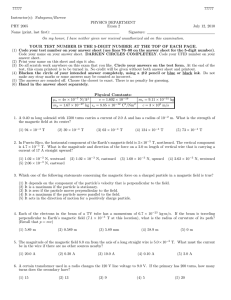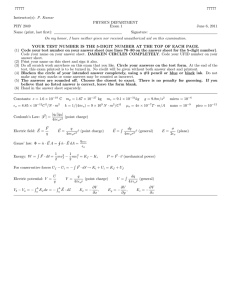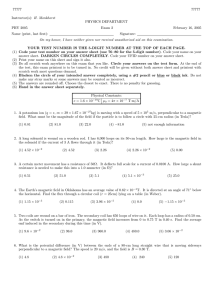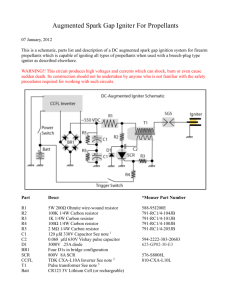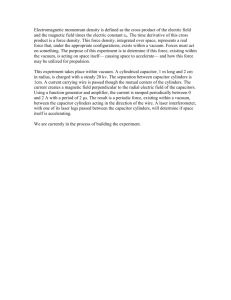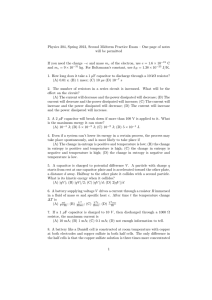77777 Nakayama/Barrow PHYSICS DEPARTMENT PHY 2005
advertisement
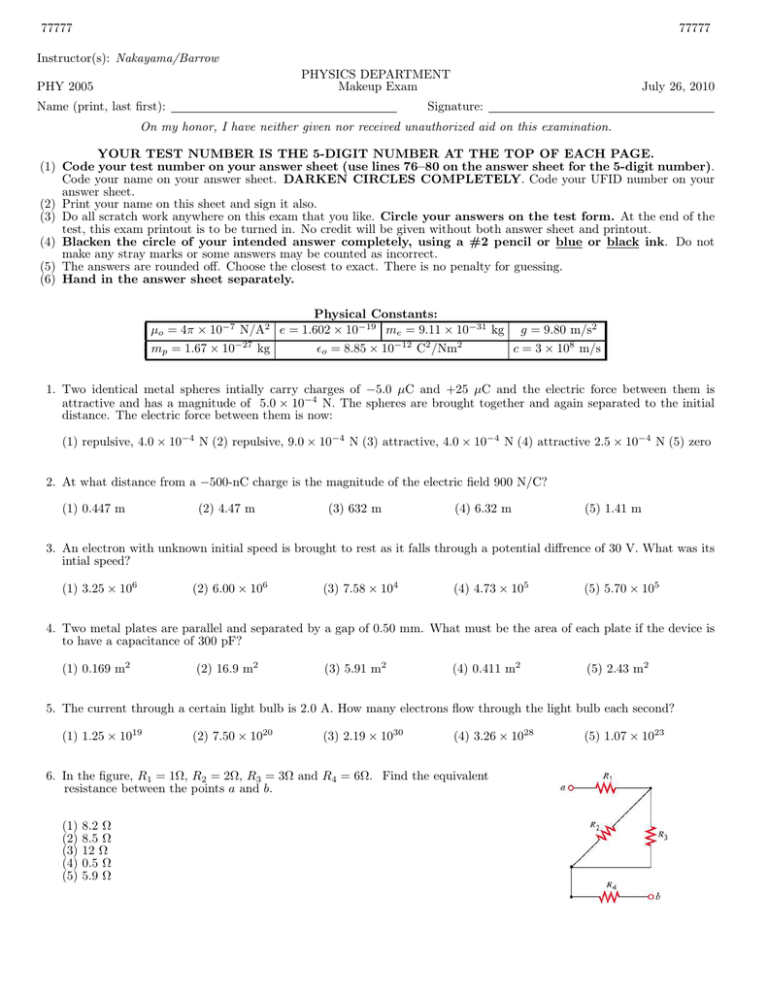
77777 77777 Instructor(s): Nakayama/Barrow PHYSICS DEPARTMENT Makeup Exam PHY 2005 Name (print, last first): July 26, 2010 Signature: On my honor, I have neither given nor received unauthorized aid on this examination. YOUR TEST NUMBER IS THE 5-DIGIT NUMBER AT THE TOP OF EACH PAGE. (1) Code your test number on your answer sheet (use lines 76–80 on the answer sheet for the 5-digit number). Code your name on your answer sheet. DARKEN CIRCLES COMPLETELY. Code your UFID number on your answer sheet. (2) Print your name on this sheet and sign it also. (3) Do all scratch work anywhere on this exam that you like. Circle your answers on the test form. At the end of the test, this exam printout is to be turned in. No credit will be given without both answer sheet and printout. (4) Blacken the circle of your intended answer completely, using a #2 pencil or blue or black ink. Do not make any stray marks or some answers may be counted as incorrect. (5) The answers are rounded off. Choose the closest to exact. There is no penalty for guessing. (6) Hand in the answer sheet separately. Physical Constants: µo = 4π × 10−7 N/A2 e = 1.602 × 10−19 me = 9.11 × 10−31 kg g = 9.80 m/s2 mp = 1.67 × 10−27 kg ²o = 8.85 × 10−12 C2 /Nm2 c = 3 × 108 m/s 1. Two identical metal spheres intially carry charges of −5.0 µC and +25 µC and the electric force between them is attractive and has a magnitude of 5.0 × 10−4 N. The spheres are brought together and again separated to the initial distance. The electric force between them is now: (1) repulsive, 4.0 × 10−4 N (2) repulsive, 9.0 × 10−4 N (3) attractive, 4.0 × 10−4 N (4) attractive 2.5 × 10−4 N (5) zero 2. At what distance from a −500-nC charge is the magnitude of the electric field 900 N/C? (1) 0.447 m (2) 4.47 m (3) 632 m (4) 6.32 m (5) 1.41 m 3. An electron with unknown initial speed is brought to rest as it falls through a potential diffrence of 30 V. What was its intial speed? (1) 3.25 × 106 (2) 6.00 × 106 (3) 7.58 × 104 (4) 4.73 × 105 (5) 5.70 × 105 4. Two metal plates are parallel and separated by a gap of 0.50 mm. What must be the area of each plate if the device is to have a capacitance of 300 pF? (1) 0.169 m2 (2) 16.9 m2 (3) 5.91 m2 (4) 0.411 m2 (5) 2.43 m2 5. The current through a certain light bulb is 2.0 A. How many electrons flow through the light bulb each second? (1) 1.25 × 1019 (2) 7.50 × 1020 (3) 2.19 × 1030 (4) 3.26 × 1028 6. In the figure, R1 = 1Ω, R2 = 2Ω, R3 = 3Ω and R4 = 6Ω. Find the equivalent resistance between the points a and b. (1) (2) (3) (4) (5) 8.2 Ω 8.5 Ω 12 Ω 0.5 Ω 5.9 Ω (5) 1.07 × 1023 77777 77777 7. In the figure, I1 = 4.0A. What is the value of R? (1) (2) (3) (4) (5) 3.6 4.8 2.4 6.0 1.0 Ω Ω Ω Ω Ω 8. 8. In the figure, E = ∞.5 V , r = 2Ω and R = 8Ω. How long a period of time does it take the resistor R to convert 30 joules of electrical energy to heat energy? (1) 167 s (2) 111 s (3) 133 s (4) 67 s (5) 667 s 9. The magnitude of the magnetic field 8.0 cm from the axis of a long straight wire is 5.0 × 10−5 T. What must the current be in the wire if there are no other sources nearby? (1) 20.0 A (2) 0.20 A (3) 10.0 A (4) 0.10 A (5) 2.0 A 10. The particle beam in a mass spectrometer consists of two types of chlorine ions. Both have the same charge and speed, but one has a mass of 35mp and the other a mass of 37mp . If the lighter one follows a path with r = 9.00 cm, what will be the radius of the path for the heavier one? (1) 9.51 cm (2) 8.51 cm (3) 9.00 cm (4) 10.02 cm (5) 8.05 cm 11. A square coil, enclosing an area with sides 8.0 cm long, is wrapped with 5000 turns of wire. A uniform magnetic field perpendicular to its plane is turned on and increases to 0.25 T during an interval of 2.0 s. What is the average current in the coil if the resistance of the coil is 8Ω? (1) 0.5 A (2) 1.3 A (3) 2.5 A (4) 4.1 A (5) 0.8 A 12. A 3 m long straight conducting wire is moving sideways with a constant speed perpendicular to a magnetic field of B = 1.5 T. The electric potential induced across the wire is 9 V. What is the speed of the moving wire? (1) 2 m/s (2) 9 m/s (3) 3 m/s (4) 0.5 m/s (5) 6 m/s 13. A 100 µF capacitor is charged to have 8 V potential difference across the capacitor. The charge stored in the capacitor is discharged through 100 kΩ resistor for 10 s. How much charge is left in the capacitor? (1) 2.94 × 104 C (2) 1.11 × 104 C (3) 0 C (4) 5.04 × 104 C (5) 1.6 × 1019 C 14. An AC series circuit has 24.00 Ω resistance, 35.00 Ω inductive reactance and 25.00 Ω capacitive reactance. If an effective (rms) emf of 120 V is applied, what is the effective (rms) current value? (1) 4.62 A (2) 2.66 A (3) 7.8 A (4) 13.0 A (5) 1.29 A 15. What frequency should a radio station have if its waves are to have a wavelength of 200 m? (1) 1.5 × 106 Hz (2) 6.0 × 1010 Hz (3) 6.67 × 107 Hz (4) 6.0 × 106 Hz (5) 1.5 × 1010 Hz
